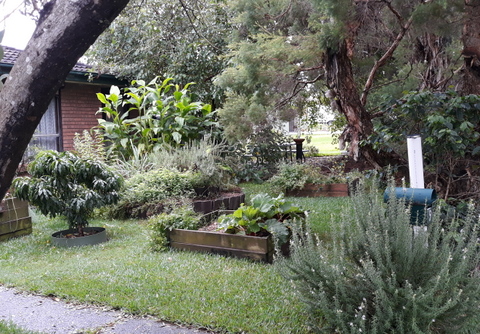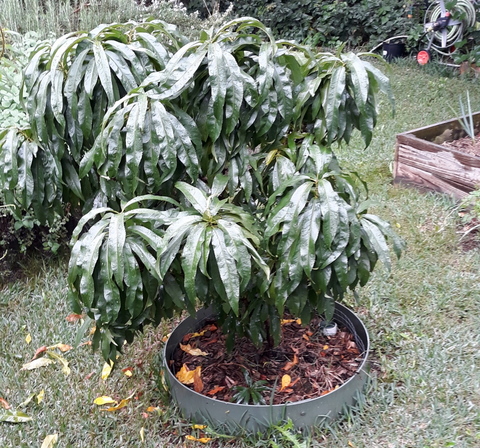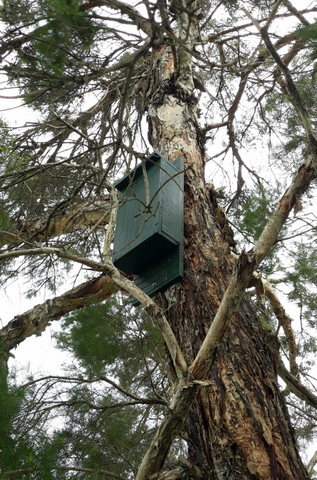The inspiration for this article series was provided by Vera Meyer in her presentation entitled “The Front Garden” to Permaculture Sydney west (7/2/2022)
Having discussed the benefits of de-lawning, and how others have de-lawned in the past, here are some hints on how you can develop your own de-lawning project -

2. Grow attractive veggies – There are lots of vegetables out there that not only taste great, but look attractive too. There are books and websites devoted to the concept of edible landscaping, “The Complete book of Edible Landscaping” by Roslind Creasy is one worth considering. For example deep purple eggplant, bright capsicum, giant globe artichokes, frilly kale, and rainbow chard are not only productive and tasty but have great visual appeal as well.
3. Keep sprawling plants under control – Climbers and ground covers such as zucchini, cucumbers, squash and tomatoes can easily get out of hand. This not only is confusing to the eye but can also impact other vegetables growing in the area. It can make harvest by you, or your neighbours, very difficult. Contain them in a raised planter, give them some vertical space by providing attractive structures to ramble over.
4. Let some of your edibles go to flower – this will have a number of benefits. Some veggies such as artichokes and chives have attractive blossoms, adding beauty to the garden. Also, allowing veggies to flower attracts pollinators to your garden, improving biodiversity and increasing productivity of your fruiting veggies. It also gives you the opportunity for saving your own seeds to provide a free feed next year.
.jpg)
5. Attract more birds and butterflies – This can be achieved planting a variety of trees and bushes with a variety of foliage types and heights. Including productive native species too will help attract our native birds. Planting fruit trees such as apples, apricots, citrus, nectarines, plums and pears may also attract butterflies and birds. Birds are great concentrators of fertility’ adding a nitrogen rich manure to your front garden. Both birds and butterflies will not only add colour to your front yard but birdsong will also provide a calming feast for the ears as well.
6. Add a dwarf fruit tree and/or fruiting bush – they will stay small when planted in the ground, in large pots or espaliered against a fence. They can, for a very small space, improve the productivity and variety of produce available, and with a bit of planning spread the harvest through the year. A fruiting shrub like a blueberry bush can provide privacy, greenery and berries

7. Ensure year ‘round interest – avoid the end of summer syndrome, incorporate productive and attractive evergreens and perennials will maintain interest and productivity throughout the year. If you are planting annual vegetables, give consideration to succession planting (sowing crops every few weeks to spread the harvest) Adding structures such as bird baths and a street library will also provide year round visual interest.
8. Encourage biodiversity and interest by adding water to the garden as a bird bath, insect water or water feature. Nothing will attract birds and beneficial insects to your garden like the offer of water on a hot summer afternoon. They will come for a drink, but stay to feed on pest species and help pollinate your fruiting crops as well. While we are at it, consider installing a bug/bee hotel and/or microbat roost box.

9. Throw away those chemical pesticides – Leave your beautiful and productive front yard to develop its own ecosystem, which will keep many pests in check. Work with nature to set up a system of growing, leaving out pesticides which will kill many beneficial insects as well as contaminating all of that beautiful and tasty produce.
10. Hide your tools – Leaving unused tools, pots and wheelbarrows (unless they are planted with flowers and designed as a feature) hanging around give the front yard and untidy look so clear them away after use.. The visual feast of all this productivity will go together to attract the eye friends, neighbours and passers by alike.
11. Share the bounty – One way of generating interest from your friends and neigbours is to share the dividends from your productive front yard around. You can set things up so that they can harvest themselves from the front of your property. Consider installing other attractions such as a community bench for them to sit and rest while they look at your progress or street library to share surplus books with your neighbours.

12. Add some colour – for the birds, the bees, and the humans! Planting beds or areas with annual flowers not only adds beauty to the garden, but flowers like alyssum, heartsease and zinnia not only attract beneficial insects they also produce edible flowers.



